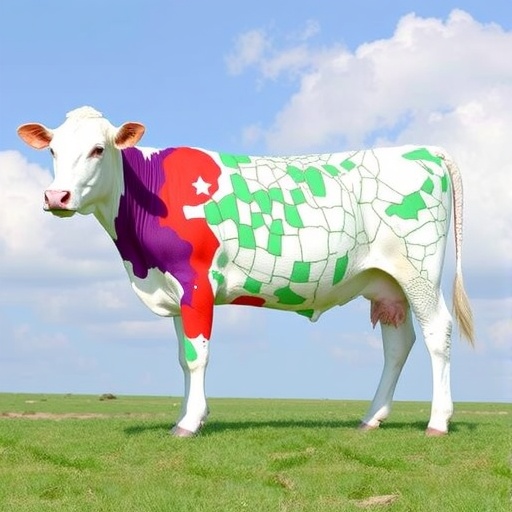In recent years, researchers have made significant strides in understanding the complexities of genetic information, particularly in livestock. A groundbreaking study led by Jiménez-Montenegro and colleagues has shed light on alternative splicing events in cows, focusing specifically on animals with distinct β-casein genotypes—A1A1 and A2A2. This research is crucial given the growing consumer interest in dairy products and the nutritional implications of different milk compositions. The identification of splicing variations not only enhances our understanding of genomic functions but could also lead to improvements in dairy cattle breeding and milk quality.
To comprehend the importance of this study, it’s essential to grasp what alternative splicing is. This biological process enables a single gene to produce multiple protein variants, thereby increasing the functional diversity of proteins. Such flexibility is vital in the context of β-casein, a primary protein in cow’s milk that impacts its nutritional value and digestibility. The A1 and A2 variants of β-casein have been linked to diverse health effects in humans, with some studies suggesting that A1 may be associated with adverse health outcomes, while A2 could be the healthier choice. Understanding the mechanisms behind these variants through alternative splicing could lead to innovative breeding strategies.
The methodology employed in the research by Jiménez-Montenegro et al. stands out due to its use of large gap read mapping, a sophisticated technique that allows for extended sequences of genetic material to be analyzed. This approach is particularly effective in identifying alternative splicing events, as it facilitates the mapping of longer DNA reads, offering a clearer picture of how these splicing variations occur in different genotypes. Traditional sequencing methods often fall short in resolving complex genomic regions, making this advanced method a game-changer in genomic research.
In their study, the researchers meticulously analyzed RNA sequences derived from cows with the A1A1 and A2A2 genotypes. By doing so, they were able to pinpoint specific events of alternative splicing linked to the β-casein gene. The findings revealed that the expression of certain splice variants was significantly different between the two genotypes, highlighting the biological divergence rooted in their genetics. This difference not only has implications for dairy quality but also for the cow’s overall health and resilience.
Furthermore, the study emphasizes the potential economic impact of such genetic insights. Dairy production is a multi-billion dollar industry, and understanding the genetic composition of dairy cattle can guide breeding programs toward more beneficial traits. Optimizing β-casein profiles to favor A2 variants could enhance consumer acceptance and marketability of dairy products, tapping into a growing demand for “healthier” milk options. This aspect of the research may resonate deeply with farmers looking for ways to increase their profitability while meeting consumer needs.
Moreover, the implications of this research extend beyond just the industry; they touch on public health as well. As more consumers become conscious of what they consume, the shift towards A2 milk—believed to be easier on digestion—presents an opportunity for health-oriented brands. Thus, the findings from Jiménez-Montenegro and his team align remarkably with current trends in dietary choices, potentially revolutionizing how milk is produced and marketed.
The genetic impact of β-casein variants underscores the intersection of genetics, nutrition, and health. Consumers are increasingly looking to understand the science behind the products they purchase, and research like that of Jiménez-Montenegro et al. directly contributes to their knowledge. It provides transparent insights into how animal genetics can influence their food, fostering informed choices and, ultimately, healthier lifestyles.
The study also opens new avenues for future research. The identification of alternative splicing events can serve as a foundation for exploring other genes with similar complexities. As genomic technologies continue to evolve, the integration of genomics with breeding strategies can amplify the health and productivity of livestock. Understanding the genotype-phenotype relationships can also facilitate the development of more resilient animal strains capable of adapting to changing climatic conditions and farming practices.
As the scientific community continues to scrutinize the genetics of dairy animals, the contribution of research such as that by Jiménez-Montenegro and his colleagues will likely catalyze innovations in genomics and breeding programs. Researchers may delve deeper into the regulatory mechanisms that govern alternative splicing, ultimately enhancing our understanding of its role in animal biology. These insights not only hold promise for the agricultural sector but also reinforce the necessity of bridging science with consumer awareness.
In summary, the study led by Jiménez-Montenegro et al. ventures beyond mere identification; it encapsulates an innovative examination of genetic diversity within dairy cattle. With the unfolding complexities of alternative splicing, this research contributes vital knowledge that could reshape dairy production and offer consumers healthier alternatives. It’s a compelling narrative that highlights the power of genetics in impacting our food systems and public health.
Moreover, as this research gains recognition, it may very well spark further discussions among geneticists, farmers, and policy-makers about the importance of investing in genetic research aimed at enhancing food quality and safety. The study not only reinforces the dynamic nature of genetic science but also the profound implications of such research for future advancements in the fields of agriculture and health.
In conclusion, the findings of Jiménez-Montenegro and his associates exemplify the integration of modern genomic tools in deciphering the intricate stories written within animal DNA. As we move forward, the dialogue between science and the marketplace will be critical, paving the way for a future where animal genetics can meaningfully influence consumer choices, dietary health, and agricultural sustainability.
Subject of Research: Alternative splicing events in cows with A1A1 and A2A2 β-casein genotypes.
Article Title: Identification of alternative splicing events in cows with A1A1 and A2A2 β-casein genotypes using large gap read mapping.
Article References: Jiménez-Montenegro, L., Urrutia, O. & Cánovas, Á. Identification of alternative splicing events in cows with A1A1 and A2A2 β-casein genotypes using large gap read mapping. BMC Genomics 26, 1048 (2025). https://doi.org/10.1186/s12864-025-12265-7
Image Credits: AI Generated
DOI: https://doi.org/10.1186/s12864-025-12265-7
Keywords: alternative splicing, β-casein, cattle genotypes, genomics, dairy quality, A1, A2, protein variants.




